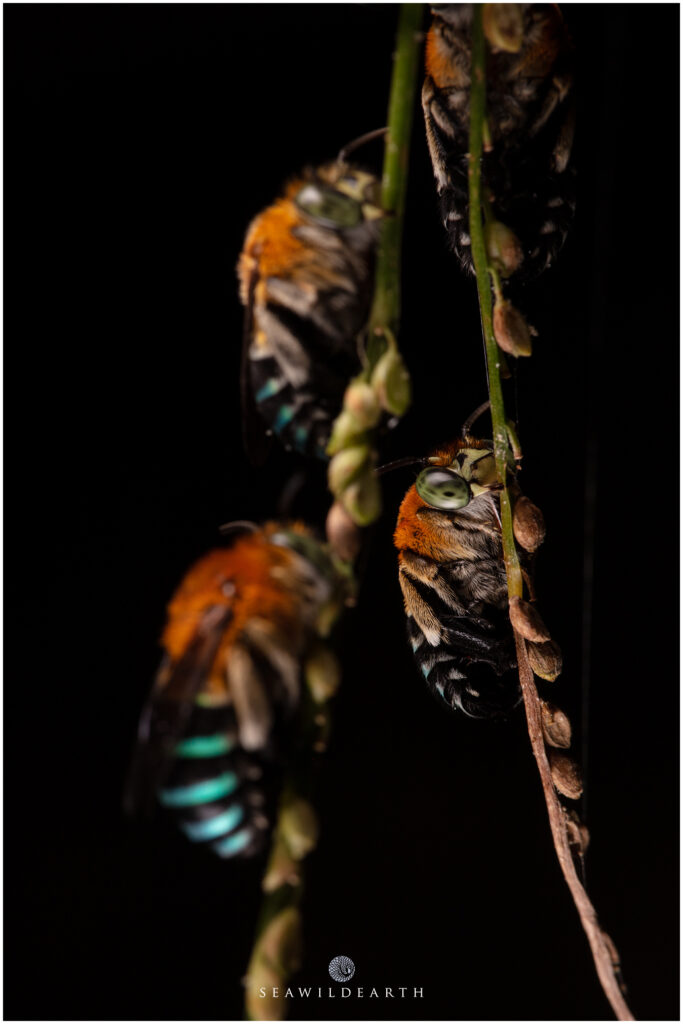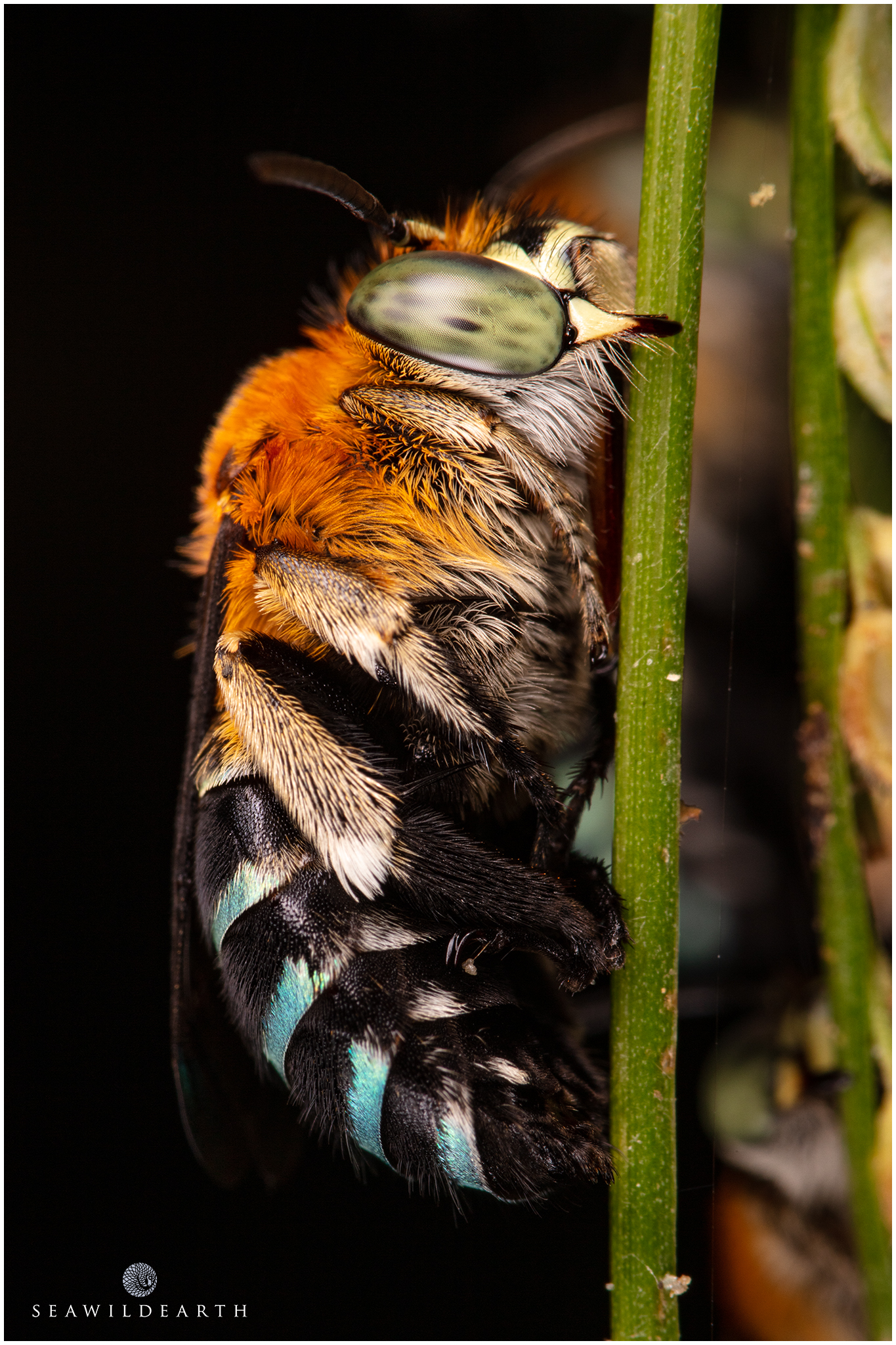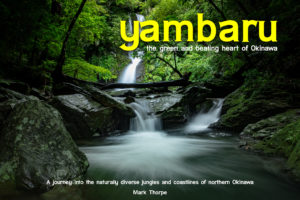Let Sleeping Bee's Lay
I happened on this pretty unique behavior by Blue Banded Bees on a recent night walk close to my apartment in Yomitan.
Blue Banded Bees are an exquisitely colored species of Bee that calls Okinawa home. By day one may see a flash of Cyan as the diminutive pollinator travel from flower to flower in their search for nectar. A few times in the past, especially around springtime, I've found myself ducking out of the way to cede passage to one of these guys as it makes its way around a particular spot of vegetation I may be checking out. By night they take to a very specific sleeping strategy. Thus far it is known that only the makes of the species engage in what can only be called column sleeping! Safety in numbers maybe?

G'night John Boy, G'night Paw...
As I was thinking to end a recent walk to discover spots for wildlife encounters around the area of Yomitan where I live in Okinawa I happened upon this amazing sight. Walking through a small dried up river bed I noted one part of overhanging vegetation with what looked like some kind congregating bugs on it. As I closed in I noted the bugs to be these incredibly colored little bees.
It is only the males of the Blue Banded Bee species that engages in this sleeping column behavior. I'm not sure where or what the females get up to or where they go but this was way too unique of an opportunity to miss. I had witnessed this behavior a few years in the past so armed with my newer 'go to' macro lens, the Laowa 60mm f2.8 2:1 macro, I set about updating the stock imagery of this critter.
Not wanting to fry, or disturb, the little guys too much I went with a half power strength on the dual strobes of my Laowa KX800 twin macro flash and decided to up the ISO to compensate. I use the Nik Collection's DeFine2 noise reduction software which I stand by as being an awesome solution for handling digital noise in imagery. Mind you it wouldn't really be needed at ISO640.
Closing in for a community shot I noted that the sleeping column would collectively 'twitch' in response to the flash firing. To this end I didn't want to take too many shots through fear of waking the Bees from their slumber. Not through fear of what they may do to me, sting wise, but due to the fact that there were also numerous Bats passing around in the night skies. I wouldn't want my desire for a shot to spell their demise due to being hunted by bats had I woken them up.
Happy with the establishing shot of a few individuals sleeping in line I took a moment for a closer look. I could see their incredible coloring as well as the detail of their mandibles, lower jaws, clamped around the stalks of the grass strands to which they were attached. Some of the strands were literally packed with a column of some fifteen Bees, all 'parked' head to tail along the length of the grass strand. It was a pretty cool thing to witness.
Moving in for a closer shot, I aimed to 'max out' the capability of this full frame lens which allows a macro ratio of 2:1. This basically means it will replicate any subject at a ratio of 2:1 or twice life size on the sensor. I felt this would be the ideal subject given these little bees were literally only around 1cm in length.
One awesome thing about this flash unit is that it comes with not only the two independent flash heads but also an independent modeling light which is housed in its own articulating arm. This means I can place the modeling/focusing light wherever I like for the shot at hand. At full power it is enough to light even the darkest of subjects or environments, especially when working at such proximity as 2:1 ratio demands.
Working at such close proximity though reduces the depth of field to a ridiculously thin sliver so the best way to exploit this is to get as much of a profile of the subject as possible. This way the viewer gets to 'enjoy' as much of the target being in focus as possible. Given I don't use a tripod for night imaging, it would simply be too laborious a process to set up a tripod for shots at night and invariably that would be enough to spook any subject anyway, I had to contort myself into a way that would allow the camera to be as still as possible. Macro photography demands you be willing to position yourself at times in the most unflattering ways to support the camera rig. So be it.
Breathing slowly I maxed the manually focusing lens to 2:1 macro ratio and moved in. It is the proximity to the subject that is the only way to focus such a lens. One has to be calm and smooth, even though the wildlife is asleep, it can be woken up and spooked at the sight of two massive, to them, diffused flash light heads being pushed towards them as well as being lit by the focusing light. Once I could see the independent cells within the compound eye of the bee I slowly squeezed the shutter button. Once the flash had fired, the bees twitched and I back away. hitting the review button of the camera I immediately zoomed in to check focus on the eye. It was good. I was done. With just a few shots taken I bode the bees a good night, thanked them for accepting my presence and for the shots I had taken and went in search of other subjects.
 2:1 macro of sleeping Blue Banded Bee using a Laowa 60mm f2.8 2:1 macro lens at f11, ISO640 1/125th sec. and 1/2 power on KX800 strobe. Camera: Canon EOS5DSr
2:1 macro of sleeping Blue Banded Bee using a Laowa 60mm f2.8 2:1 macro lens at f11, ISO640 1/125th sec. and 1/2 power on KX800 strobe. Camera: Canon EOS5DSr
I am happy with the resulting image of this lone male Blue Banded Bee. If nothing it's an update from the shot I had taken some 3years prior. I continue in my search for suitable wildlife spots in the southern confines of Okinawa. Something that can then be enjoyed by those wanting to encounter the amazing diversity of life on this island without the need for the long and protracted drive to the northern jungles of the Yambaru.
"Nature is so powerful, so strong. Capturing its essence is not easy - your work becomes a dance with light and the weather. It takes you to a place within yourself".
Annie Leibovitz - Photographer
About the Author
Internationally recognized as a provider of quality mixed media Mark Thorpe is always on the search for captivating content.

Photographer / Cameraman
Mark Thorpe
Emmy Award Winning wildlife cameraman and Internationally published landscape photographer Mark Thorpe has been an adventurer since he could walk! Spending 17yrs as an Underwater Cameraman at the start of his imaging career the highlight of which was being contracted to work with National Geographic. In that role as a field producer and cameraman he's been privy to a mixed bag of hair raising adventures. For some reason he was always selected for projects relating to large toothed marine predators such as Great White and Tiger Sharks, Sperm Whales and Fur Seals. Additionally he has also been active within Southern Africa on terrestrial projects dealing with a wide array of iconic wildlife.
Currently based in Okinawa, Japan he's always on the lookout for his next big adventure. He shares his exploits online with a totally organic social audience in excess of 200,000. Sponsored by a number of photographic industry manufacturers he is constantly scouring the islands for captivating landscape and ocean scape compositions. In videography, he continues to create short photographic tutorial videos as well as creating content about the diversity of wildlife within Okinawa and the Ryukyu Islands of Southern Japan.
 Whenever that rarest of commodities is available, spare time, Mark continues to photograph the flora and fauna of Okinawa that will eventually be used to compile a Coffee Table Book project. 'Yambaru - The Green Beating Heart of Okinawa' is planned to showcase the diversity of wildlife species and landscapes that make up the incredible location known as the Yambaru, the rolling green jungles of Northern Okinawa. Mark has also devised a way for folks to become involved with that project via a support page on the Patreon social platform. For a small monthly donation, used to offset the travel and time to create the book, those willing to are in effect embarking on a 'lay away' project to secure a copy of the book which will also be signed by Mark as a sign of gratitude for the support. More information about this option can be found on the Patreon Profile for the project.
Whenever that rarest of commodities is available, spare time, Mark continues to photograph the flora and fauna of Okinawa that will eventually be used to compile a Coffee Table Book project. 'Yambaru - The Green Beating Heart of Okinawa' is planned to showcase the diversity of wildlife species and landscapes that make up the incredible location known as the Yambaru, the rolling green jungles of Northern Okinawa. Mark has also devised a way for folks to become involved with that project via a support page on the Patreon social platform. For a small monthly donation, used to offset the travel and time to create the book, those willing to are in effect embarking on a 'lay away' project to secure a copy of the book which will also be signed by Mark as a sign of gratitude for the support. More information about this option can be found on the Patreon Profile for the project.
